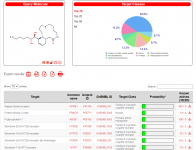FellaAndrene
Well-known member
Question for @Sam_Skunkman - Have you (or anyone you know) ever bioassayed cannabisativine and/or the other lactam based alkaloids in Cannabis?
I was browsing through ElSohly's works, and it happened to me that cannabisativine's molecular structure could have some affinity to other receptors than the CB1 and CB2.
Running it through Swiss Target Prediction's database returned results for possible interaction with kappa opioid (salvinorin A target) and 5-HT2A (classical psychedelic) receptors.
I'm not that well versed in 5-HT2A pharmacophore, but the receptors certainly are very accepting towards a wide variety of different compounds (from piperazines to phenethylamines to lysergides to efavirenz).
Can you send me the reference of the El Sohly paper, as well as the paper the image is from?
-SamS
I was browsing through ElSohly's works, and it happened to me that cannabisativine's molecular structure could have some affinity to other receptors than the CB1 and CB2.
Running it through Swiss Target Prediction's database returned results for possible interaction with kappa opioid (salvinorin A target) and 5-HT2A (classical psychedelic) receptors.
I'm not that well versed in 5-HT2A pharmacophore, but the receptors certainly are very accepting towards a wide variety of different compounds (from piperazines to phenethylamines to lysergides to efavirenz).
Can you send me the reference of the El Sohly paper, as well as the paper the image is from?
-SamS
Attachments
Last edited by a moderator:









